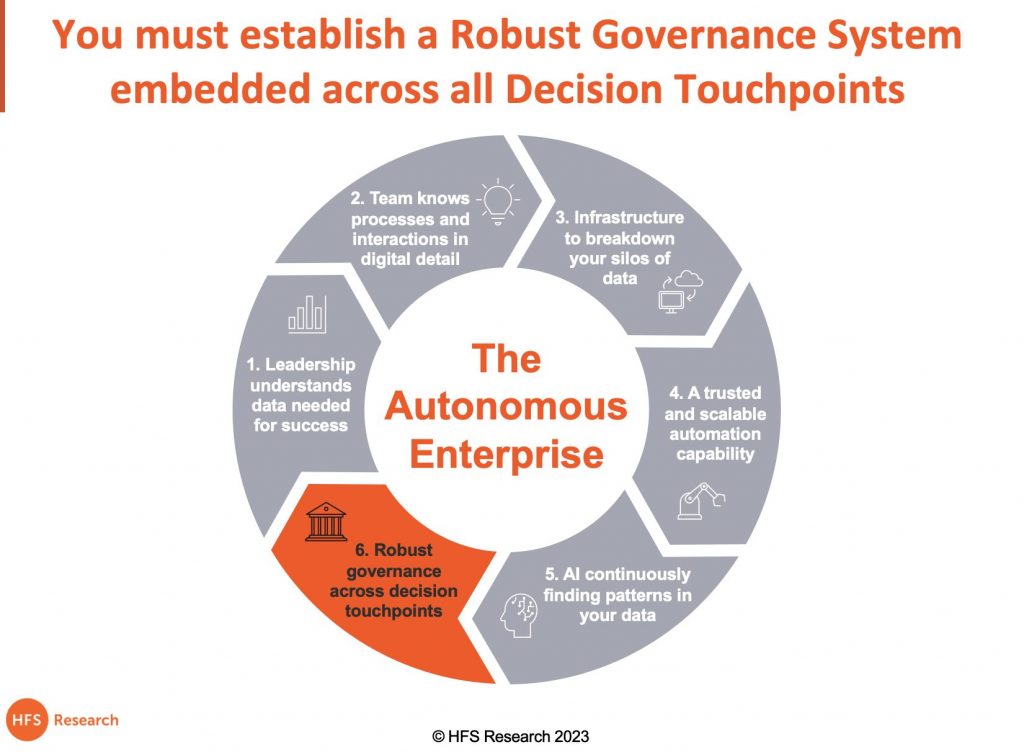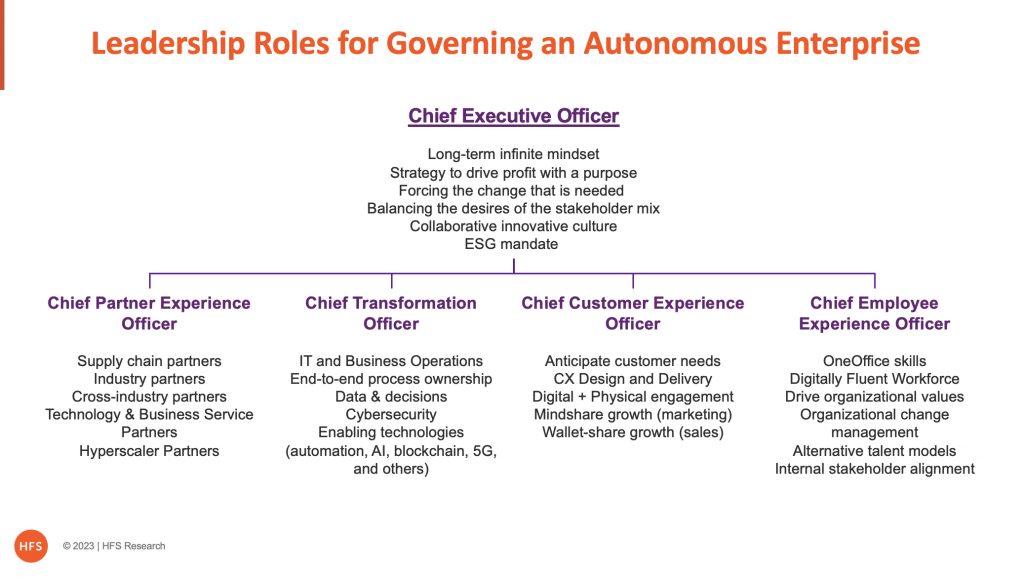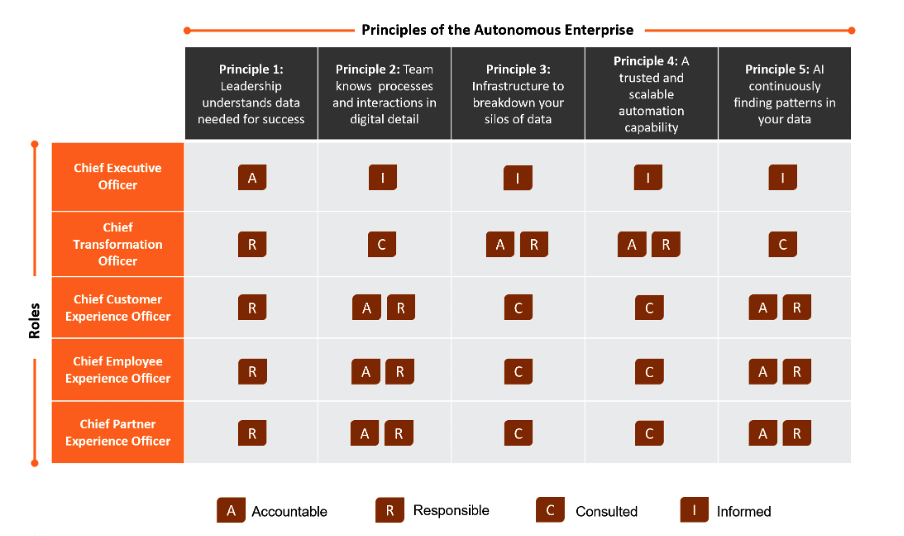In our recent post discussing “The Six Principles of the Autonomous Enterprise,” we touched on all the key behaviors and technologies that must come together as smart leadership continuously seeks to refine the data it needs, in real-time, to be successful. We need to delve much deeper into the roles, traits, and responsibilities enterprise leaders must develop if autonomous enterprises are going to be effective in their emerging ecosystems:

A robust governance system embedded across all decision touchpoints guides the effectiveness of your autonomous enterprise
A strong governance capability has the talent, tech infrastructure, automation, and AI to deliver the data that will drive success with minimal manual interventions that impede progress and speed. The ultimate goal of an autonomous enterprise allows us humans to remove ourselves from some parts of the system so that we can make continuous improvements to the ecosystem as a whole.
Ultimately this is about machines making decisions where we previously had humans and removing humans from loops that don’t need humans anymore. Leadership must understand the data they need to be successful and assemble and govern the right system to deliver success. Hence great governance is about maximizing the ability of talent to understand and access data, make rapid decisions based on that data and have a seamless infrastructure that houses that centralized data, and embed an effective risk management framework. Bringing together those processes and interactions with trusted and scalable automation frees humans from slowing down decisions and operating effectively in fast-changing ecosystems.
What are the leadership roles needed to understand the data they need? How can we build the right internal teams and external partnerships to support an autonomous enterprise? And how can we design smart governance to manage key decisions faster with some degree of confidence? It really boils down to breaking down internal silos and designing leadership roles to drive better decisions and support talent.
These are the roles – and leadership traits – that will optimize the value from autonomous enterprise models

The Chief Executive Officer: The CEO should be the leader who drives the infinite mindset across the organization. He/she must continuously define the purpose of the organization and relentlessly drive a fearless collaborative culture that values stakeholder value beyond shareholder value. As a leader, it’s so easy to obsess with operational functions of the business during times of disruption or distress – in this case, a global pandemic – that it can create knee-jerk, often short-term decisions that could inherently damage your long-term vision, your business’ culture and your raison d’être. With no defined time horizon, no clearly-defined rules, and with players that may enter and exit at any time, the primary objective of an infinite game is quite simply to keep playing. The goal for businesses is to have the will and resources to stay in the game through thick and thin. And none more so that the current unpredictable and challenging business environment.
Having lived and worked through four recessions, I personally understand the rapid change in leadership mindset that can occur when a firm goes from peacetime and growth to one of survival and all-out war. According to author Simon Sinek, people look to leadership to serve and protect, to “set up their organizations to succeed beyond their lifetimes.” But in the modern landscape, most organizations place an unbalanced focus on near-term results that may ultimately prove to be self-defeating, like casting aside your umbrella in a storm because you haven’t been getting wet. In short, business is no finite endeavor. This pandemic lays plain for all to see the game we are really playing.
The CEO is the ultimate collaborator, forcing the change that is needed and balancing the desires of the various stakeholders (the board, key clients, key partners, the employees). His/her/their team to make this happen, must be responsible for the full gamut of their customers, employees, and partners, working with a transformational wizard to bring together the process and technology with the real innovation ingredient: the people. Taking people out of routine work that should be automated or digitized and refocusing them on responsibilities that require real innovation and cultural affinity is so valuable.
Chief Transformation Officer: Any transformation leader worth their salt must be able to drill an autonomous mindset into their teams and work out a plan to implement the right technologies to form the baseline to break down silos and centralize critical data.
This leader must link front to back office and ensure processes run smoothly across functions to deliver the data/outcomes the organization needs. This should ideally be someone who understands the challenges of enterprise operations and how to align them with the market-facing/client-impact areas of the firm. Forget the old GBS head / shared services head role, as this just has repeatedly failed to get out of the transactional back-office world and the “finance factory”. This person must oversee both technology and operations, understand the value of automation and AI, be able to design and implement change programs and work closely with the employee experience leader to eliminate the back office mindset from antiquated business functions into one that is aligned with the direction of the business.
Chief Customer Experience Officer: This is the leader who lives and breathes the world of the customers and obsesses with how to engage them as effectively as possible – right across the entire customer life-cycle – both with talented humans and autonomously where humans are not necessary. Ideally is someone who understands how to design customer interfaces, how to service customer needs leveraging both digital tools and physical support, and ensuring the entire employee base is unified around (and incentivized on) driving customer impact. In addition, the CCXO must ensure the marketing mindset is to communicate with the customer, educate the customer, and develop specific programs that have a real impact on driving customer engagement and business growth.
Chief Employee Experience Officer: Forget transactional HR, the employee experience leader is the person responsible for making the company a great, energizing place to work, where staff of all backgrounds, ages, experience levels cultures are energized by the values and desired outcomes of the firm. The CEXO must drive trust across managers and staff to embrace autonomous technologies and craft roles that maximize human interactions. Noone wants to be stuck in zombie roles in this environment where ambitious leaders demand value from their talent, delighting customers, colleagues and key partners. Never has there been a time when people skills are more important, supported by trusted and robust technologies and data infrastructures.
This individual must be the person who can manage the expectations of the board, the CEO, and the shareholders to create a company culture and values that everyone believes in. Moreover, the CEXO must be intimately involved in the creation and execution of training programs across the firm to attract talent who want to work for a company that will develop them, as well as establishing a culture and values they can identify with. This should ideally be a strong leader with broad experience in the business and staff development, who knows what it takes to be successful, and who understands how to motivate people beyond pure compensation. The best leaders today are also great people managers – and the CEXO role must be at the core of the business leadership, not some ancillary executive painting lip service and not having any real impact.
Chief Partner Experience Officer: As the OneEcosystem environment evolves, the need to collaborate with entities with common objectives across the entire customer value chain has never been so prominent. Partners are no longer just your suppliers. Suppliers are essential partners in delivering your goods/services. Still, the OneEcosystem looks at partners more holistically – partners in the ecosystem involved in providing the customer experience across the entire customer lifecycle.
An autonomous enterprise needs to function autonomously both internally and externally. Essentially, the OneOffice and OneEcosystem are effective when processes and interactions require fewer manual interventions and data can be accessed in centralized repositories. It requires leadership to have the ability to continuously refine the data it needs in real-time to be successful right across both internal and external ecosystems and the CPXO is the leader to drive this mindset into practice.
In the age of transparency, these roles must be codified to ensure accountability
It is not enough to provide a high-level description of the key roles that will govern an autonomous ecosystem – enterprises must codify the responsibilities of each one of them to ensure transparency when measuring their effectiveness.
As highlighted below, adherence to each principle of the Autonomous Enterprise comes with different responsibility levels across the leadership roles.
We believe the CEO should ultimately be accountable for understanding data needed for success. Thinking about data as an “ecosystem builder” requires a mindset and cultural change – if the CEO does not show the way, nobody will. The CEO’s mandate is to lead the way and be directly accountable for the overall performance of transitioning into a data-driven enterprise.

The Bottom-line: The old way of running businesses is fast eroding as we rethink what constitutes success and ambition. Bring on autonomous principles to drive the next wave of innovation
We launched the “HFS Enterprise Innovation Framework” in 2022 that enables organizations to survive (Horizon 1: Digital), thrive (Horizon 2: OneOffice), and ultimately lead (Horizon 3: OneEcosystem). One of the six distinct organization characteristics for enterprises to successfully create the OneEcosystem will be “autonomous processes” which allow firms to operate with less inefficiency in order to make faster decisions.
Did you ever think your enterprise could move to a 100% work-from-home environment with less than three weeks’ notice? This era of constant change has forced businesses to flex – vastly accelerating the OneEcosystem environment, dramatically cutting redundancies and improving processes at scale. Essentially OneOffice and OneEcosystem are effective when processes and interactions require fewer manual interventions and data can be accessed in centralized repositories. Hence leaders need to understand the data they need, have the right teams/partnerships to support them, and have smart governance in place to manage their decision points. The Autonomous Enterprise principles, if followed by smart, ambitious leaders, will enable the OneEcosystem mindset to prosper and provide the discipline and clean data needed to be effective.
There is a massive amount of change happening, and out of change comes real transformation. After years and years of complacency due to the relentless growth (and papering over the cracks of 2008), all of today’s organizations now finally have a burning platform to change how they operate globally. In fact, the autonomous platform is positively on fire!
Posted in : Artificial Intelligence, Automation, Autonomous Enterprise, Buyers' Sourcing Best Practices, Metaverse, OneEcosystem, OneOffice, Process Discovery, Process Mining, Robotic Process Automation, Talent and Workforce, The Great Resignation






